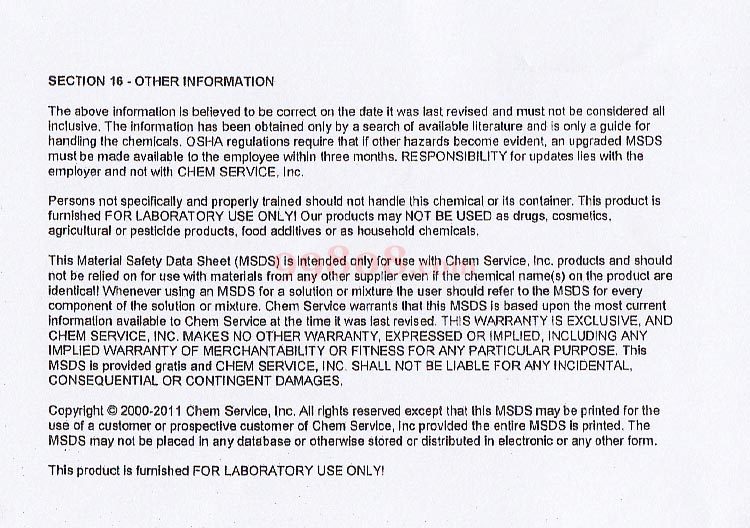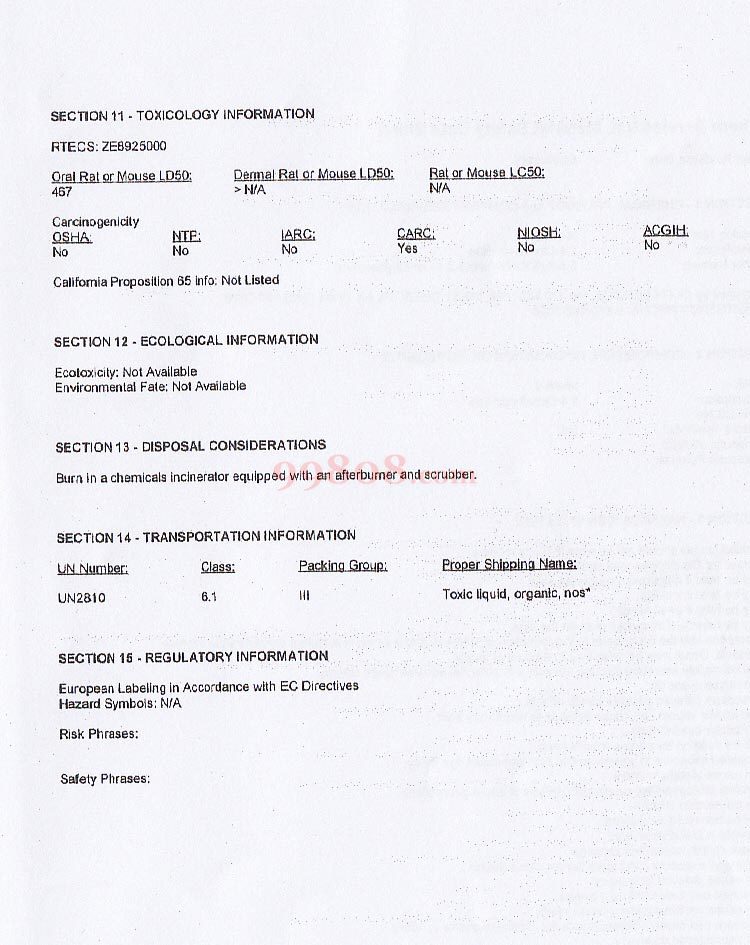
同商品型号列表:
产品基本说明:
| Purity is >98% |
当前型号详情:

产品介绍:








Chem Service Inc. Material Safety Data Sheet
Last Revision Date: 06/24/2011
SECTION 1 - CHEMICAL PRODUCT and COMPANY IDENTIFICATION
Catalog Number: N-10637
Description: 2.4-Dimethylaniline
Other Names: 2.4-Xylidine/1-Amino-2,4-Dimethylbenzene
Supplied by CHEM SERVICE, Inc. PO BOX 599, WEST CHESTER, PA 19381 (610)-692-3026
EMERGENCY PHONE: 1-610-692-3026
SECTION 2 - COMPOSITION, INFORMATION ON INGREDIENTS
CAS: 95-68-1
Description: 2.4-Dimethylaniline
EINECS No:
Hazard Symbols: N/A
Molecular Weight:
Molecular Formula:
SECTION 3 - HAZARDS IDENTIFICATION
Contact lenses should not be worn in the laboratory
Suspected Carcinogen-may produce cancer.
May be fatal if absorbed through the skin!
May be fatal if inhaled!
May be fatal if swallowed!
May be harmful if absorbed through the skin.
Absorption into the body leads to the formation of Methemoglobin which in sufficient concentration causes
cyanosis. Onset may be delayed 2 to 4 hours or longer.
May be rapidly absorbed through the skin with potential adverse health effects.
Can cause cyanosis.
Can cause delayed adverse health effects.
Dust and/or vapors can cause irritation to respiratory tract.
Can cause eye irritation.
Can be irritating to mucous membranes.
Repeated exposure to vapors and/or dust can cause eye injury.
Can cause blood disorders.
Possible mutagen-May cause birth defects in future generations.
Can cause skin irritation.
May be harmful if swallowed.
Possible cumulative poison.
Exposure can cause liver damage.
Prolonged exposure can cause severe skin irritation.
Can cause delayed lung injury.
Exposure can cause kidney damage.
Can cause cardiovascular system injury.
Exposure can cause nausea, headache dizziness and/or vomiting.
Can cause blood disorders.SECTION 4 - FIRST AID MEASURES
An antidote is a substance intended to counteract the effect of a poison. It should be
administered only by a physician or trained emergency personnel. Medical advice can be
obtained from a POISON CONTROL CENTER.
In case of contact: Flush eyes continuously with water for 15-20 minutes. Flush skin with water for 15-20
minutes.
If no burns have occurred-use soap and water to cleanse skin.
If inhaled remove patient to fresh air. Administer oxygen if patient is having difficulty breathing.
If patient has stopped breathing administer artificial respirations.
If patient is in cardiac arrest administer CPR.
Continue life supporting measures until medical assistance has arrived.
Remove and wash contaminated clothing.
Get medical attention if necessary.
If patient is exhibiting signs of shock - Keep warm and quiet.
Contact Poison Control Center immediately if necessary.
Do not administer liquids or induce vomiting to an unconscious or convulsing person.
If patient is vomiting-watch closely to make sure airway does not become obstructed by vomit.
Get medical attention if necessary.
SECTION 5 - FIRE AND EXPLOSION DATA
Flash Point: Extinguishing Media:
90 C Carbon dioxide, dry chemical powder or spray.
Upper Explosion Limit: Lower Explosion Limit: Auto Ignition:
7 1.5 460
NFPA Hazard Rating:
Health Flammability Reactivity Special
0 - Least, 1 - Slight, 2 - Moderate, 3 - High, 4 - Severe
SECTION 6 - ACCIDENTAL RELEASE MEASURES
Spills or leaks: Evacuate area. Wear appropriate OSHA regulated equipment. Ventilate area.
Absorb on vermiculite or similar material.
Sweep up and place in an appropriate container.
Hold for disposal.
Wash contaminated surfaces to remove any residues.
Remove contaminated clothing and wash before reuse.SECTION 7 - HANDLING AND STORAGE
Handling:
This chemical should be handled only in a hood. Eye shields should be worn.
Use appropriate OSHA/MSHA approved safety equipment.
Avoid contact with skin, eyes and clothing. Avoid ingestion and inhalation
Wash thoroughly after handling.
Storage:
Store in a cool dry place. Store only with compatible chemicals. Keep tightly closed.
SECTION 8 - EXPOSURE CONTROLS/PERSONAL PROTECTION
OSHA PEL (TWA): ACGIH TLV (TWA): ACGIH TLV (STEL):
5 ppm (25 mg/m3) 2 ppm(10 mg/m3) skin N/A
Personal Protective Equipment
Eyes: Wear Safety Glasses.
Skin: Wear appropriate protective gloves to prevent skin exposure.
Clothing: Wear appropriate protective clothing to minimize contact with skin.
Respirators: A respiratory protection program that meets OSHA''s 29 CFR 1910.134 requirements
must be followed whenever workplace conditions warrant a respirator''s use.
SECTION 9 - PHYSICAL AND CHEMICAL PROPERTIES
Color: Colorless to pale yellow
Phase: Liquid
Melting Point: -14.3 C
Boiling Point: 214-218 C
Specific Gravity: 0.980
Vapor Density: 4.2
Vapor Pressure:.16mm@25 C
Solubility in water: Insoluble (immiscible)
Odor: Aromatic
Evaporation Rate: N/A
Molecular Weight:
Molecular Formula:
SECTION 10 - STABILITY AND REACTIVITY
Emits toxic fumes under fire conditions.
Container may explode under fire conditions.
Combustible.
Incompatible with strong acids.
Reacts with Acid halides and anhydrides.
Incompatible with strong oxidizing agents.
Incompatible with Chloroformates.
Decomposition liberates toxic fumes.
Sensitive to heat.
Readily absorbed and retained on clothing and/or shoes.
Incompatible with halogens.
Volatile.
Sensitive to light - dark color does not affect purity.SECTION 11 - TOXICOLOGY INFORMATION
RTECS: ZE8925000
Oral Rat or Mouse LD50: Dermal Rat or Mouse LD50: Rat or Mouse LC50:
467 > N/A N/A
Carcinogenicity
OSHA: NTP: IARC: CARC: NIOSH: ACGIH:
No No No Yes No No
California Proposition 65 info: Not Listed
SECTION 12 - ECOLOGICAL INFORMATION
Ecotoxicity: Not Available
Environmental Fate: Not Available
SECTION 13 - DISPOSAL CONSIDERATIONS
Burn in a chemicals incinerator equipped with an afterburner and scrubber.
SECTION 14 - TRANSPORTATION INFORMATION
UN Number: Class: Packing Group: Proper Shipping Name:
UN2810 6.1 III Toxic liquid, organic, nos*
SECTION 15 - REGULATORY INFORMATION
European Labeling in Accordance with EC Directives
Hazard Symbols: N/A
Risk Phrases:
Safety Phrases:SECTION 16 - OTHER INFORMATION
The above information is believed to be correct on the date it was last revised and must not be considered all
inclusive. The information has been obtained only by a search of available literature and is only a guide for
handling the chemicals. OSHA regulations require that if other hazards become evident, an upgraded MSDS
must be made available to the employee within three months. RESPONSIBILITY for updates lies with the
employer and not with CHEM S